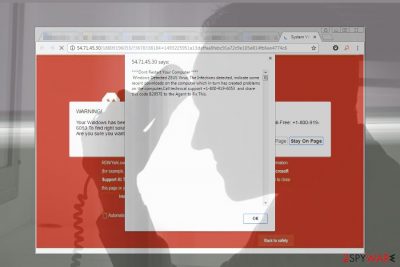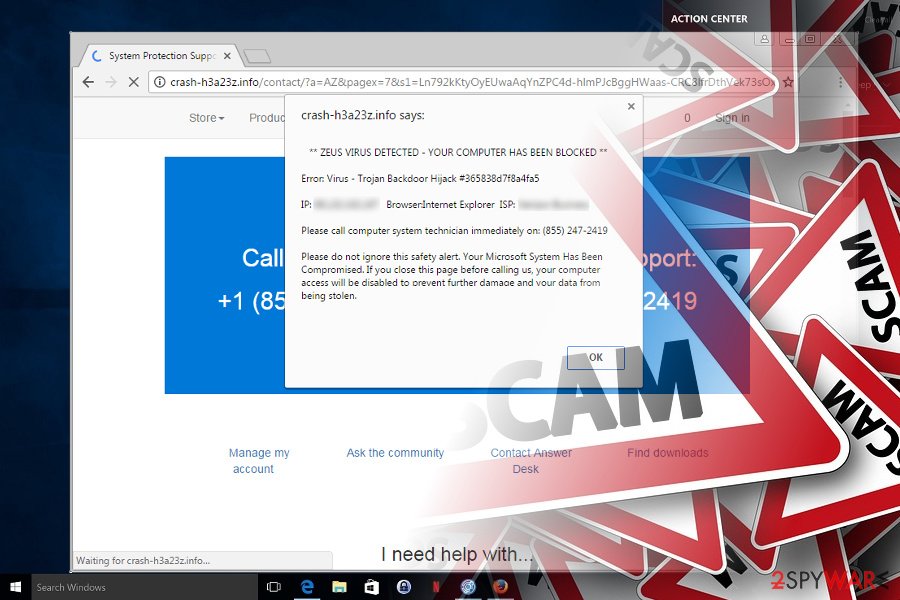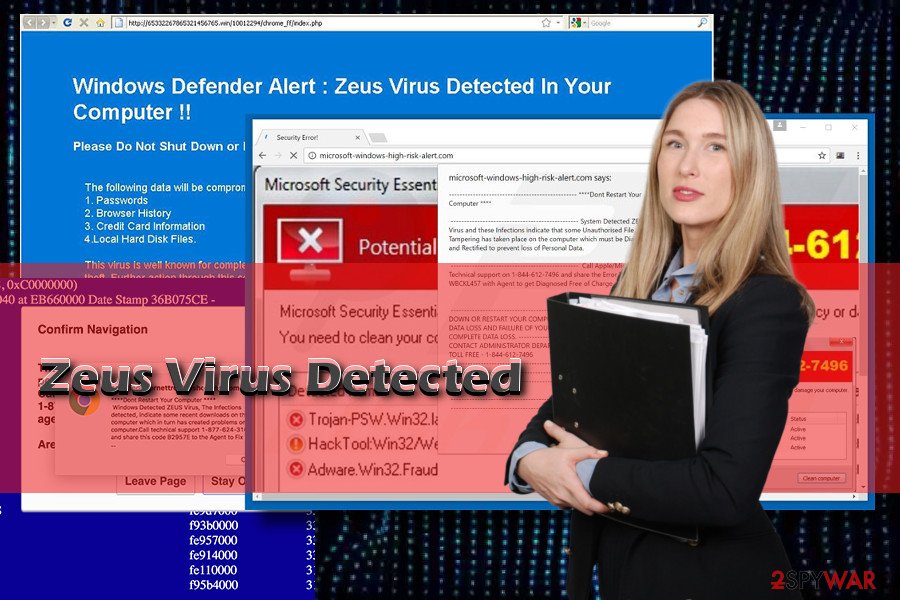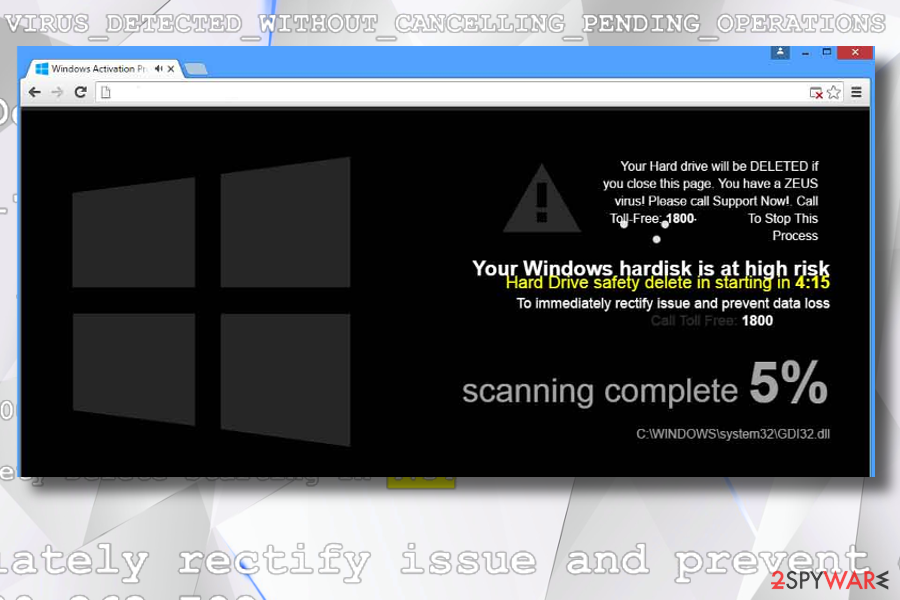Zeus Virus Detected (Removal Guide) - Free Instructions
Zeus Virus Detected Removal Guide
What is Zeus Virus Detected?
Zeus Virus Detected is a fake Microsoft warning distributed by scammers

Zeus Virus Detected is a fake warning message that people can witness while browsing the Internet. It can show up on both, Mac and Windows OS and may even lock down the Google Chrome, Mozilla Firefox, Microsoft Edge, Safari or any other targeted web browser. Despite the fact that Zeus virus is a real cyber infection that had been considered as one of the most dangerous viruses from 2007 until 2011,[1] the alert has nothing in common with a genuine virus and belongs to tech support scam category.
| Name | Zeus Virus Detected |
|---|---|
| Classification | Malware |
| Category | Technical Support Scam[2] |
| Symptoms | Web browser redirects to fake websites urging people to call for support due to malicious virus infection. Browser can also freeze, crash, and generate excessive amount of commercial ads. |
| Main dangers | Microsoft Technical Support Scam alerts are not dangerous. They do not have destructive effect on the system. However, the danger level increases if the PCs owner falls for calling the given number. In this case, the risk of money loss or identity theft is high. |
| Versions |
“Windows Detected ZEUS Virus” |
| Distribution | Scam alerts are caused by adware-type programs that spread bundled with freeware |
| Elimination process | Download FortectIntego and run a full system scan with it. It will eliminate scam-related malware and other unwanted programs. After malware elimination, reset your web browser's settings. |
The name of this infection is actively misused by scammers who seek to make their Tech-Support-Scam alerts look as convincing as possible. The fake Zeus Virus alert typically renders the design of Microsoft’s official notifications[3] and impersonates “Certified Microsoft technicians.” Mobile numbers included in the alert are yet another trait that allows recognizing a scam. At the moment, security experts report about these fake Microsoft tech support numbers:
- +1-844-313-7003
- +1-866-625-5558
- +1 (888) 944-5714
- +1-877-224-2995
- +1-844-557-540
- 1-844-859-0337
- 1-844-324-6233
- 1-844-680-1071
- 1-800-363-782
- 1-877-624-3165
- 1-844-612-7496
- (866) 249-2994
- (888) 202-7560
- (855) 247-2419
- (888)-252-1520
- 0800-014-8826
- 44-800-090-3820
Since this type of scam is being actively distributed on the Internet, people have to be cautious and remember the fact that Zeus is not active since 2012 and there's no chance of getting infected with it. The pop-up is only a strategy used by criminals to make the content of fake alerts more convincing and threatening.

The modus operandi of the scam
There are many versions of the related scams, but all of them share similar circumstances of the occurrence, design, content, behavior, and intentions. Typically, this specific tech support scam strikes PC users who fail to update OS, web browser, and security programs. It is closely related to adware-type programs that are infected with malicious JavaScrip[4] code. If the potential victim falls for installing scam-infected adware, his or hers web browser experiences unauthorized modifications needed to initiate regular system’s redirects to compromised web domains.
In some of the cases, adware is not necessary to encounter the scam. It may be disguised under illegal movie streaming websites, gambling sites or domains that contain pornography. Currently, these are domains that generate the fake Zeus Virus Detected alert:
- Crash-h3a23z.info
- Certifiedinternettroubleshooting.com
- Microsoft-high-risk-alert.com
- Rajasthantent.com
- 54.71.45.30
- Defaultprogramssystem.com
- Support.windows.com
- Streetsecurity.xyz, etc.
In most of the cases, the web browser stumbles upon the alert after multiple redirects. It tends to show up in layers. First of all, a blue, black or red screen containing technical information is being displayed. In less than 10 seconds, a pop-up alert emerges and freezes web browser. That’s one of the strategies used by criminals to scare people into thinking that their PCs are severely infected.

The content of the Zeus virus detected alert is very similar, though can differ a little bit each time. As a rule, fake alerts contain the following details:
- A slogan reporting Zeus infection;
- An error code, which may be invented or randomly taken from the Windows error database (#365838d7f8a4fa5, 0XB1983959, # 0x80072ee7[5] );
- A supposedly unique victim’s identification number (WBCKL457, B2957E, G3468D);
- A list of data that is supposedly targeted by criminals (passwords, credit card details, hard disk files, etc.)
- “Toll-Free” mobile number of “Certified” Microsoft or Apple technicians (+1-844-313-7003, (866) 249-2994, (888) 202-7560).
The main goal of Zeus virus detected scams
Unlike the virus itself, Zeus-themed scams are not that dangerous. Fake pop-ups flooding web browser’s screen are triggered by the adware-type program, which does not have a destructive effect on the system. The goal of the scam is to make people dial the given number.
At best, the number provided may be the premium rate, meaning that a one minute of conversation can cost you $2.99 or more. However, usually, scammers have much bigger and much worse intentions. They can professionally impersonate Microsoft technicians to prove credibility and then extort personal information from gullible people. More often than not, impostors seek to extort information needed for remote connection to victim’s PC.

Therefore, to prevent yourself from being scammed, scan your PC with FortectIntego, SpyHunter 5Combo Cleaner or Malwarebytes as soon as your web browser starts generating fake alert messages reporting a non-existent virus infection. No matter which version of this scam you encounter, remove Zeus Virus Detected from Chrome or another web browser without delay.
Scammers rely on bundling to distribute scam alerts
People risk encountering technical support scam alerts when visiting illegal websites, such as gambling, adult dating or pornographic websites. Such domains are usually filled with infected ads and malicious links.
Nevertheless, scam alerts typically show up right after the installation of freeware. Free applications are frequently supplemented with adware-type and other potentially unwanted programs (PUPs). Usually, they are promoted as useful browser add-ons, toolbars, extensions or plug-ins. People who opt for Quick or Recommended freeware installation setup agree with the installation of the whole bundle by default.
Consequently, if one of the adware injected in freeware was infected with a JavaScript code, web browser's settings get compromised in a way to generate fake Microsoft support notifications. NoVirus.uk[6] cybersecurity experts recommend people to opt for Advanced or Custom installation freeware and verify each installation step to prevent unwanted apps from installing.
A guide on how to remove Zeus Virus Detected scam
One of the options to initiate Zeus Virus Detected removal is to perform a full system scan with a professional anti-virus program. That's the only trustworthy way to eliminate the whole malware bundle. Our recommended programs are FortectIntego, SpyHunter 5Combo Cleaner, and Malwarebytes, but you can opt for another reputable anti-virus of your preferences.
It's possible to remove Zeus Virus Detected alert manually as well. This procedure encompasses several stages. First of all, you have to eliminate PUPs from the system using in-built uninstallers. Then, check the system for related Registry entries, and other associated components. Finally, open a new session of the affected web browser (NOTE: do not restore the last browsing session) and reset its settings. You can find a step-by-step tutorial down below:
You may remove virus damage with a help of FortectIntego. SpyHunter 5Combo Cleaner and Malwarebytes are recommended to detect potentially unwanted programs and viruses with all their files and registry entries that are related to them.
Getting rid of Zeus Virus Detected. Follow these steps
Uninstall from Windows
Zeus Virus Detected scam elimination process on Windows requires performing the steps provided below. Initiate each step in right order.
Instructions for Windows 10/8 machines:
- Enter Control Panel into Windows search box and hit Enter or click on the search result.
- Under Programs, select Uninstall a program.

- From the list, find the entry of the suspicious program.
- Right-click on the application and select Uninstall.
- If User Account Control shows up, click Yes.
- Wait till uninstallation process is complete and click OK.

If you are Windows 7/XP user, proceed with the following instructions:
- Click on Windows Start > Control Panel located on the right pane (if you are Windows XP user, click on Add/Remove Programs).
- In Control Panel, select Programs > Uninstall a program.

- Pick the unwanted application by clicking on it once.
- At the top, click Uninstall/Change.
- In the confirmation prompt, pick Yes.
- Click OK once the removal process is finished.
Delete from macOS
Fake warnings can strike Mac OS users as well. Although these cases are less common, many people search for help on how to get rid of scam pop-ups once and for all. The following instructions will help you:
Remove items from Applications folder:
- From the menu bar, select Go > Applications.
- In the Applications folder, look for all related entries.
- Click on the app and drag it to Trash (or right-click and pick Move to Trash)

To fully remove an unwanted app, you need to access Application Support, LaunchAgents, and LaunchDaemons folders and delete relevant files:
- Select Go > Go to Folder.
- Enter /Library/Application Support and click Go or press Enter.
- In the Application Support folder, look for any dubious entries and then delete them.
- Now enter /Library/LaunchAgents and /Library/LaunchDaemons folders the same way and terminate all the related .plist files.

Remove from Microsoft Edge
Just like IE users, people affected by fake Microsoft tech-support scam on Edge should follow the tutorial on how to restore its settings before the attack.
Delete unwanted extensions from MS Edge:
- Select Menu (three horizontal dots at the top-right of the browser window) and pick Extensions.
- From the list, pick the extension and click on the Gear icon.
- Click on Uninstall at the bottom.

Clear cookies and other browser data:
- Click on the Menu (three horizontal dots at the top-right of the browser window) and select Privacy & security.
- Under Clear browsing data, pick Choose what to clear.
- Select everything (apart from passwords, although you might want to include Media licenses as well, if applicable) and click on Clear.

Restore new tab and homepage settings:
- Click the menu icon and choose Settings.
- Then find On startup section.
- Click Disable if you found any suspicious domain.
Reset MS Edge if the above steps did not work:
- Press on Ctrl + Shift + Esc to open Task Manager.
- Click on More details arrow at the bottom of the window.
- Select Details tab.
- Now scroll down and locate every entry with Microsoft Edge name in it. Right-click on each of them and select End Task to stop MS Edge from running.

If this solution failed to help you, you need to use an advanced Edge reset method. Note that you need to backup your data before proceeding.
- Find the following folder on your computer: C:\\Users\\%username%\\AppData\\Local\\Packages\\Microsoft.MicrosoftEdge_8wekyb3d8bbwe.
- Press Ctrl + A on your keyboard to select all folders.
- Right-click on them and pick Delete

- Now right-click on the Start button and pick Windows PowerShell (Admin).
- When the new window opens, copy and paste the following command, and then press Enter:
Get-AppXPackage -AllUsers -Name Microsoft.MicrosoftEdge | Foreach {Add-AppxPackage -DisableDevelopmentMode -Register “$($_.InstallLocation)\\AppXManifest.xml” -Verbose

Instructions for Chromium-based Edge
Delete extensions from MS Edge (Chromium):
- Open Edge and click select Settings > Extensions.
- Delete unwanted extensions by clicking Remove.

Clear cache and site data:
- Click on Menu and go to Settings.
- Select Privacy, search and services.
- Under Clear browsing data, pick Choose what to clear.
- Under Time range, pick All time.
- Select Clear now.

Reset Chromium-based MS Edge:
- Click on Menu and select Settings.
- On the left side, pick Reset settings.
- Select Restore settings to their default values.
- Confirm with Reset.

Remove from Mozilla Firefox (FF)
To remove Zeus Virus Detected virus from your web browser completely, navigate to browser's settings as explained below and reset its settings.
Remove dangerous extensions:
- Open Mozilla Firefox browser and click on the Menu (three horizontal lines at the top-right of the window).
- Select Add-ons.
- In here, select unwanted plugin and click Remove.

Reset the homepage:
- Click three horizontal lines at the top right corner to open the menu.
- Choose Options.
- Under Home options, enter your preferred site that will open every time you newly open the Mozilla Firefox.
Clear cookies and site data:
- Click Menu and pick Settings.
- Go to Privacy & Security section.
- Scroll down to locate Cookies and Site Data.
- Click on Clear Data…
- Select Cookies and Site Data, as well as Cached Web Content and press Clear.

Reset Mozilla Firefox
If clearing the browser as explained above did not help, reset Mozilla Firefox:
- Open Mozilla Firefox browser and click the Menu.
- Go to Help and then choose Troubleshooting Information.

- Under Give Firefox a tune up section, click on Refresh Firefox…
- Once the pop-up shows up, confirm the action by pressing on Refresh Firefox.

Remove from Google Chrome
The bulk of people experiencing intrusive pop-up alerts uses Google Chrome. The solution to this problem is simple. Adware infection can be eliminated from Chrome quite simply – by resetting it to default.
Delete malicious extensions from Google Chrome:
- Open Google Chrome, click on the Menu (three vertical dots at the top-right corner) and select More tools > Extensions.
- In the newly opened window, you will see all the installed extensions. Uninstall all the suspicious plugins that might be related to the unwanted program by clicking Remove.

Clear cache and web data from Chrome:
- Click on Menu and pick Settings.
- Under Privacy and security, select Clear browsing data.
- Select Browsing history, Cookies and other site data, as well as Cached images and files.
- Click Clear data.

Change your homepage:
- Click menu and choose Settings.
- Look for a suspicious site in the On startup section.
- Click on Open a specific or set of pages and click on three dots to find the Remove option.
Reset Google Chrome:
If the previous methods did not help you, reset Google Chrome to eliminate all the unwanted components:
- Click on Menu and select Settings.
- In the Settings, scroll down and click Advanced.
- Scroll down and locate Reset and clean up section.
- Now click Restore settings to their original defaults.
- Confirm with Reset settings.

Delete from Safari
Remove unwanted extensions from Safari:
- Click Safari > Preferences…
- In the new window, pick Extensions.
- Select the unwanted extension and select Uninstall.

Clear cookies and other website data from Safari:
- Click Safari > Clear History…
- From the drop-down menu under Clear, pick all history.
- Confirm with Clear History.

Reset Safari if the above-mentioned steps did not help you:
- Click Safari > Preferences…
- Go to Advanced tab.
- Tick the Show Develop menu in menu bar.
- From the menu bar, click Develop, and then select Empty Caches.

After uninstalling this potentially unwanted program (PUP) and fixing each of your web browsers, we recommend you to scan your PC system with a reputable anti-spyware. This will help you to get rid of Zeus Virus Detected registry traces and will also identify related parasites or possible malware infections on your computer. For that you can use our top-rated malware remover: FortectIntego, SpyHunter 5Combo Cleaner or Malwarebytes.
How to prevent from getting malware
Access your website securely from any location
When you work on the domain, site, blog, or different project that requires constant management, content creation, or coding, you may need to connect to the server and content management service more often. The best solution for creating a tighter network could be a dedicated/fixed IP address.
If you make your IP address static and set to your device, you can connect to the CMS from any location and do not create any additional issues for the server or network manager that needs to monitor connections and activities. VPN software providers like Private Internet Access can help you with such settings and offer the option to control the online reputation and manage projects easily from any part of the world.
Recover files after data-affecting malware attacks
While much of the data can be accidentally deleted due to various reasons, malware is one of the main culprits that can cause loss of pictures, documents, videos, and other important files. More serious malware infections lead to significant data loss when your documents, system files, and images get encrypted. In particular, ransomware is is a type of malware that focuses on such functions, so your files become useless without an ability to access them.
Even though there is little to no possibility to recover after file-locking threats, some applications have features for data recovery in the system. In some cases, Data Recovery Pro can also help to recover at least some portion of your data after data-locking virus infection or general cyber infection.
- ^ The Zeus Virus. Tech-FAQ. Tech-relate information.
- ^ Tech support scams. Microsoft. Windows Defender Security Intelligence.
- ^ Michael Moore. Microsoft warns users against new security phone SCAM. Express. Daily online newspaper.
- ^ Catalin Cimpanu. Unstoppable JavaScript Attack Helps Ad Fraud, Tech Support Scams, 0-Day Attacks. BleepingComputer. Technical support site and a self-education tool.
- ^ Jake Doe. How to fix Error 0x80072ee7 on Windows 10?. UgetFix. Informational website on how to solve problems in Windows and Mac operating systems.
- ^ Novirus. Novirus. Virus and spyware news.























